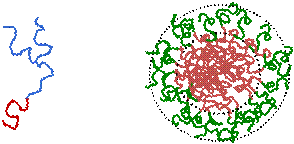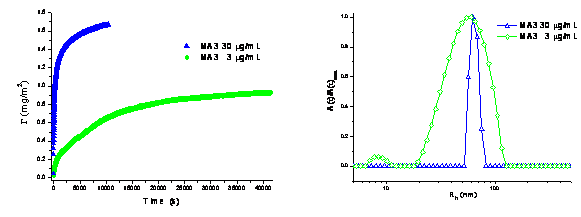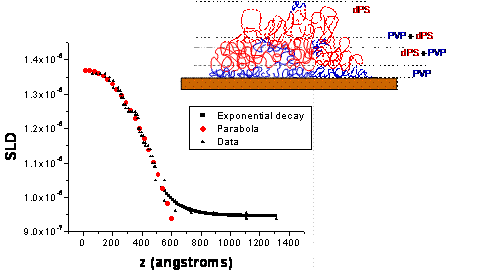AmericanChemicalSociety.com
Reports: AC7 47185-AC7: Structural and Frictional Interactions between Microphase Segregated, Multi-Component Polymer Brushes
S. Michael Kilbey, University of Tennessee
Our PRF-sponsored research aims to examine the structure and interactions of self-organized, complex block copolymers, both when self-assembled into thin films at the solid-fluid interface, but also in solution, where they form micelles, vesicles, or nanoparticles. Copolymers consisting of two or more chemically dissimilar blocks share distinctive traits with small-molecule surfactants, perhaps most notably the ability to spontaneously organize into ensembles comprised of many single molecules. The size and shape of those supramolecular ensembles are determined by the composition, connectivity, and sequence of the constituent chains and the set of interactions those materials have with their solution environment. Polymer micelles or vesicles are of practical importance for applications such as drug delivery or enhanced oil recovery, and those supramolecular ensembles also are of broad interest as building blocks in nanotechnology. Nevertheless, our understanding of the links between polymer architecture, self-assembled structure, and dynamics and interactions is quite limited.
Figure 1. Architecturally-complex copolymers studied,
including mikto-arm (mixed arm) star-like copolymers (left) consisting of a
branched polyisoprene block (blue) and a polystyrene end block (red); and
highly branched star block copolymers (right) having polystyrene core blocks
and poly(2-vinylpyridine) coronas (green). To address
this we are investigating the self-assembly of branched and multi-component
block copolymers, focusing on how chain topology and interactions influences
structure and surface properties, especially surface relaxations. We have used
light scattering to determine the structure of self-organized, branched block
copolymers in preferential solvents and a variety of surface sensitive
techniques to examine kinetics of preferential adsorption and thin film
morphology. Our investigations to date have involved three-arm “mikto-arm”
(mixed arm) star-like copolymers consisting of polystyrene and polyisoprene and
highly branched stars having arms consisting of poly(2-vinylpyridine-block-polystyrene) diblock copolymers, both
of which are represented schematically in Figure
1. The former set of copolymers has been studied in n-hexane, which is
preferential for polyisoprene and assembly and surface structure of the latter
set has been examined in toluene, which is preferential for polystyrene. The main experimental
method used in the adsorption studies is phase modulated ellipsometry, which provides
high sensitivity, a low signal-to-noise ratio, and time resolution as short as
10 ms. Moreover, a feedback loop provides excellent long-time stability,
enabling the kinetics of adsorption to be followed over very long periods. Using
these copolymer systems and complementary insights obtained through modeling,
we have demonstrated that the kinetics of assembly and surface relaxations are
significantly impacted by architecture and solution concentration. In cases
where the assembly is conducted from a micellar solution, as in the PS/PI
mikto-arm star copolymer system, the kinetics of preferential adsorption depend
strongly on surface relaxation/ reorganization events because the
diffusion-controlled regime ends rather quickly (within a few 10's of seconds).
As shown in Figure 2, the adsorption
process is also significantly impacted by the dynamic equilibrium that exists
between single chains and supramolecular ensembles. Figure 2. Results from phase modulated ellipsometry and
dynamic light scattering showing how kinetics of preferential adsorption (left)
and hydrodynamic size distribution of micellar aggregates (right), respectively,
are affected by concentration of micelles in solution. These studies of the assembly and dynamics of
self assembled miktoarm star-like copolymers reveal exchange of chains between
free solution and the micellar structures that in turn impact relaxations and
reorganization of the supramolecular ensembles at the solid-fluid interface. In the case
of the highly-branched polystyrene/polyvinylpyridine (PS/PVP) star-block
copolymers, we found that the adsorption process depends sensitively on star composition:
the adsorption of symmetric stars appears to follow a random sequential
adsorption (RSA) model, and for all styrene:vinylpyridine ratios examined, the evolution
of layer structure is strongly influenced by surface relaxation events. In
fact, model fitting shows that at lower concentrations the adsorption of the
PS/PVP stars is dominated by surface reorganization events, rather than
diffusion. We have also used neutron reflectometry to examine the nanoscale
structure of ultrathin films formed by adsorption of the PS/PVP star-block
copolymers; as shown in Figure 3, we
find that due to internal crowding, not all of the PVP arms are able to reach
the surface. Figure
3.
Scattering length density (SLD) profile for a highly asymmetric PS/PVP
star assembled on a silicon surface. The
fit indicates that not all of the PVP is able to “find” the surface. Final steps
in the project involve examining nanoscale structure of the star block
copolymers in various solution environments using liquids reflectometry and to
examine the dynamic behavior and solution structure of these copolymers using
light scattering methods. We also plan
on examining structural response of surface tethered, multicomponent systems as
solvent environment is changed. These systems are being made both by
preferential adsorption of multicomponent block copolymers at the solid-fluid
interface and also by surface grafting, which involves reacting polymers onto
solid substrates. The results emerging from our studies provide a basis for
understanding how macromolecular architecture and composition can be used to
tune self-assembled structure and properties.
A clear and final challenge is to link the solution structure and
dynamics to specific surface relaxation processes occurring upon adsorption. These
research activities have fostered the development of a graduate student and a
postdoctoral researcher. Through this work they have developed expertise in dynamic
light scattering and in neutron reflectivity through participation in scattering
experiments at national user facilities (such as the NIST Center for Neutron
Research and the Spallation Neutron Source at Oak Ridge National Laboratory).
As a result of those research activities as well as through training and
mentoring, our research group has increased its capabilities by expanding the
suite of techniques that can be brought to bear on understanding the formation,
organization, and properties of polymer-modified interfaces.

Copyright © American Chemical Society



